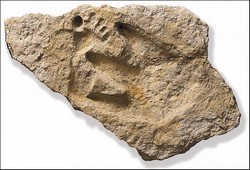

|
| Fig. 1. Alvis Delk Print (Thumbnail linked from Mineral Wells Index website) |
In 2008 strict creationist Carl Baugh announced on his Creation Evidence Museum (CEM) website that he was in the possession of a "pristine" human footprint overlapped by a theropod dinosaur track in Cretaceous rock. If such a find were genuine, it would conflict with extensive geologic and paleontologic evidence indicating that humans did not exist on earth until at least 60 million years after non-avian dinosaurs went extinct. Baugh's CEM report asserts that subsequent CT scans of the rock confirms the authenticity of the tracks and eliminates any possibility of carving or alteration. However, Baugh has a long history of unsupported claims about "out-of-place" human prints, including examples on loose slabs rock slabs (Kuban and Wilkerson, 1989) and others in the Paluxy riverbed . From what can be assessed based on the photos and sketchy information provided so far by the print advocates, the pattern appears to continue.
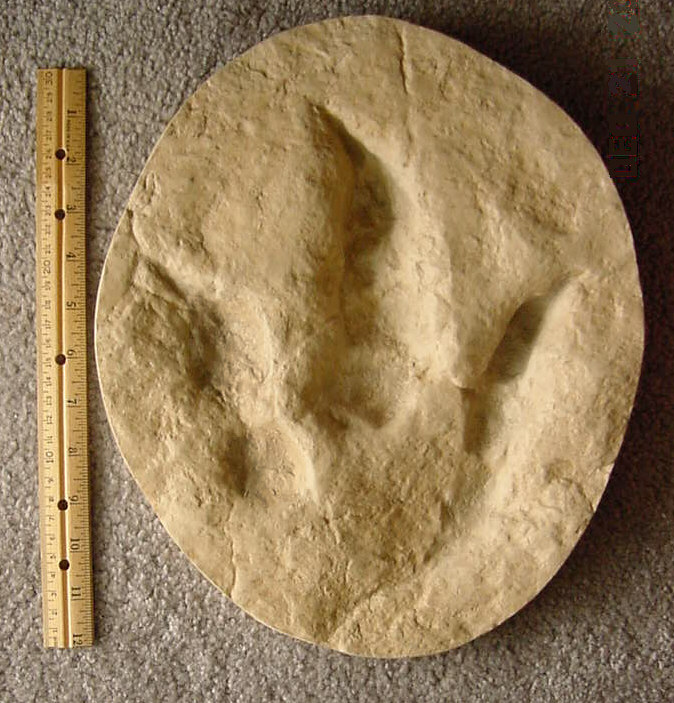
| ||
|
Fig. 3 Cast of a genuine juvenile dinosaur track (probably made by Acrocanthosaurus). from the Paluxy Riverbed, Glen Rose, Texas. Photo (C) Glen J. Kuban
| 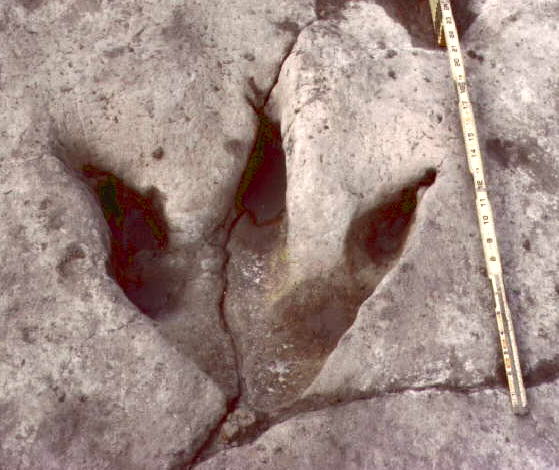
Fig. 4 A well-preserved adult theropod track. | (probably made by Acrocanthosaurus). Paluxy Riverbed, Glen Rose, Texas. Photo (C) Glen J. Kuban |
The CEM website indicates that in July 2000, "amateur archaeologist" Alvis Delk, assisted by James Bishop, both of Stephenville Texas, discovered the eleven inch "human footprint intruded by the dinosaur track" while working in the Cretaceous Limestone "in the vicinity of McFall Site I and II Sites where the Creation Evidence Museum team has been working since 1982." These sites are located near Glen Rose, Texas, just west of Dinosaur Valley State Park, and less than a mile from Baugh's little museum.
An image of the Delk print is now prominently featured on the home page of the CEM website (and the opening banner). Although the photos show the prints on a loose block of rock, a reader might easily misconstrue from Baugh's brief description that the tracks were found on an original track bed and later removed. Potentially fostering this impression is a notation on the Delk specimen photographs by David Lines, which read "In the Sir George Series"-- a term Baugh previously used for a series of alleged human tracks on an actual track bed near the McFall property. However, David May reported in the July 28, 2008 Mineral Wells Index that Delk and Bishop found the Delk specimen in an already loose condition in a pile of rocks along a creek that flows into the Paluxy River, and that they thought it only contained a dinosaur track. As recounted by David May, about eight months ago Delk took a bad fall from a ladder, and in order to pay medical bills, decided in May 2008 to sell some of his possessions--at which time he brushed off the track slab better and discovered the human print. Subsequently, as the story goes, he toted the 140 pound rock slab to Baugh, who purchased it from him.
Some commentators have suggested that some of the reported circumstances of the find seem curious, asking why an experienced amateur archaeologist such as Delk would find something as wonderful as a dinosaur track on a loose rock, and yet not immediately clean it, or notice that it overlapped a human footprint almost as deep, until almost eight years later. Others have noted that his friend Bishop repeatedly expressed the expectation that their find would "change history" and "disprove Darwin's Theory," and questioned why Delk took the print to a man well known for promoting dubious human tracks instead of a reputable research facility. Finally, some questioned the timing of the incident--noting that this took place during a time when some strict creationists were pushing to receive more exposure of their views in Texas public schools.
While these circumstantial issues are too speculative to be more than marginally relevant, they underscore a more central and scientific concern: the lack of in situ documentation, which leaves uncertain the exact location of the original track bed, and whether both prints and all their details were originally part of it. To date it has not even been clearly established that the rock is Cretaceous, let alone that it was part of a specific track bed near Glen Rose. David Lines, a long-time supporter of Baugh, suggests that print contains "a number of fossils commonly found in North Texas such as small sea shells and shell fish" and that this "lends credence to the stone's authenticity. However, to date he has presented no specifics (such as names and photos of the fossil species involved) to support this. And even if the stone were demonstrated to be Cretaceous, it would not demonstrate that the prints on it were genuine. In this regard, let us review the physical attributes of the prints themselves, which show a number of serious problems.

|
|
Fig. 1. Close-up of "human print" on Delk Slab Photograph by David Lines |
Ian Juby, another a long-time Baugh supporter, suggests that such criticisms are unfounded, on the grounds that "Human footprints take on a remarkable and strange variety of shapes and forms." (Juby, 2008) Yes, footprints do vary considerably in appearance, due to variations in foot size, shape, movement, and sediment consistency. However, I am not familiar with any genuine footprints showing the complete suite of abnormalities displayed in the Delk print, or a comparable level of overall aberrance. For more information on the key features of genuine human prints, see "Foot Notes of an Anatomist" by Laurie Godfrey (1985). Moreover, some of the problems (especially in the toe region) are so severe that each alone would undermine the print's authenticity.
Continuing his attempt to justify the odd features of the print, Juby states that "it would be far more convincing if it were a "perfect" track, so why the imperfection? It makes more sense that it is a legitimate, albeit strange, track." (Juby, 2008). However, Juby neglects some simpler and more plausible explanations. One is that a forger might simply lack the ability to create a natural looking footprint. Another is that a carver might start from one or more already existing depressions in a rock, such as the deep hole now seen as a "big toe" and perhaps the depression in the ball area, and/or an indistinct dinosaur track (notice that in Fig. 8 below, the scan slice at this level shows only such depressions). If this occurred, it would not be the first time. In the 1970's, Glen Rose resident Wayland "Slim" Adams, explained to a group of creationists how his uncle George Adams, who carved human tracks on loose blocks and sold them to tourists during the Great Depression, usually did start with existing (but not human) depressions. George's granddaughter recently confirmed this, as well as her grandfather's use of acid to blur chisel marks.(Kennedy, 2008)
Juby finally remarks that "That footprint is completely human, there is no other creature that makes a footprint like a human." Here he neglects the fact that humans can make footprints with tools as well as their feet. He also doesn't mention that some creatures (including certain dinosaurs) are known to have sometimes left superficially human-like tracks, and that in some cases such tracks were selectively enhanced and/or misinterpreted as human footprints (Kuban, 2006) Juby also suggests that if the track was a perfect track, the skeptics would say "it's too perfect, it's obviously a carving...that's what they've argued before with other human tracks from the Paluxy!"(Juby, 2008). However, I've intensively studied the Paluxy tracks and associated "man track" controversy for many years, and to my knowledge no scientist has claimed that any alleged human print there was "too perfect" in the sense of being both distinct and natural looking. The only Paluxy-related tracks that show a complete set of distinct human features, such as the Burdick Print, show serious anatomic abnormalities (the Burdick track is also on a loose block of rock, and is generally accepted as one of George Adams' carvings, even by many creationists).
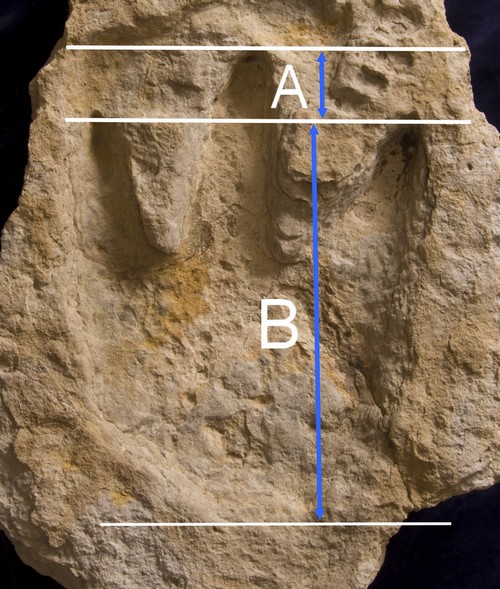
|
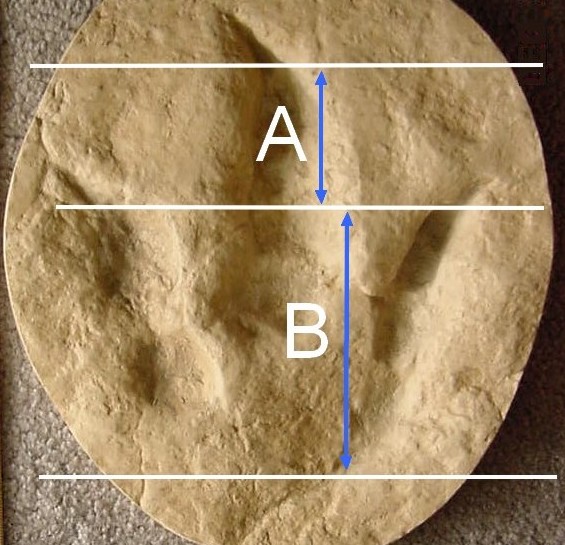
|
| Fig. 5 Delk Track showing ratio of middle digit extension to length of other digits | Fig. 6 Real juvenile theropod track cast showing ratio of digit extension to length of other digits |
Baugh said he believes that both prints on the Delk slab were made in soft clay or mud "within minutes, or at most hours of each other" about 4,500 years ago, around the time of Noah’s Flood, and that the dinosaur trackmaker would have weighed "a few tons"(May, 2008). However, Baugh didn't explain, if these things were so, how the dinosaur would have left a track almost as deep as the human print (some parts of the "human" print are as deep or even deeper than parts of the dino track). Nor did he explain how humans and dinosaurs came to be strolling around together during a violent global flood (his "Flood model" holds that Cretaceous sediments were deposited during the Flood). Baugh remarked that the Delk print is the "proof he has been looking for many years,"(May, 2008), which seems like a curious statement considering that he has previously claimed to have documented dozens of clear human tracks in Cretaceous rock (Baugh, 2008).

|
| Fig. 7. Loose track slabs (likely carvings) reportedly originating in the Stephenville area and sold to tourists in Glen Rose in the last few years Note the distinct outlines but unusually flat bottoms. Photo (C) 2007, Glen J. Kuban |
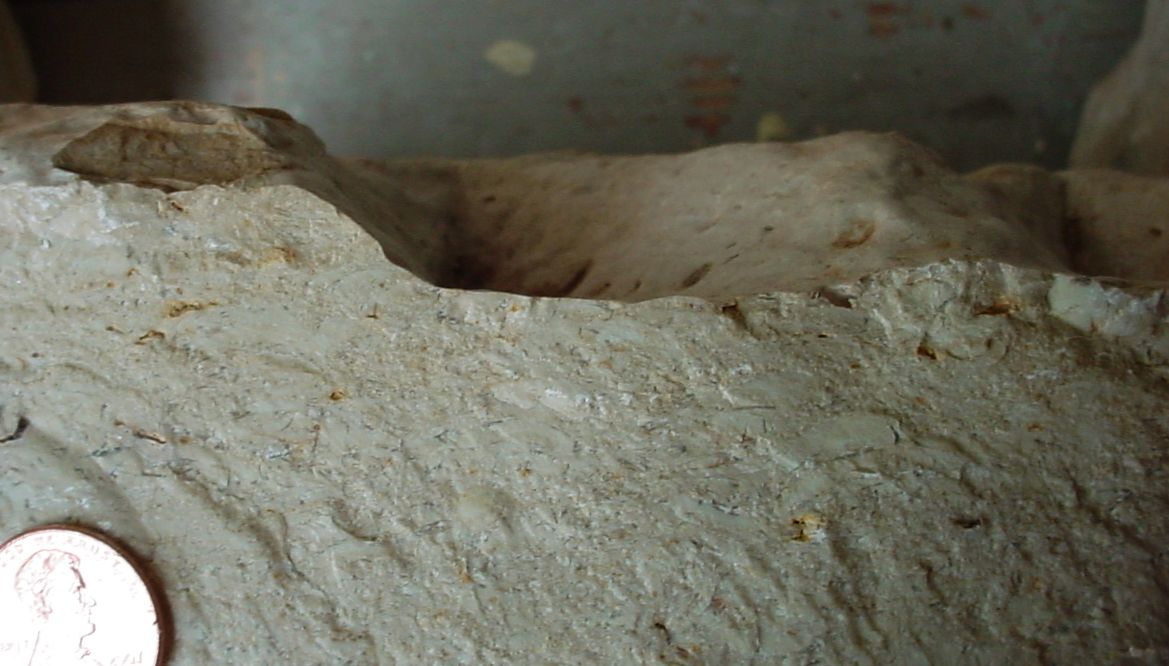
|
| Fig. 8. Subsurface of one of the cracked loose tracks shown above. Note the truncated features and lack of deformational lines, suggesting a carved origin. Photo (C) 2007, Glen J. Kuban |
Gary Hurd (2008) states, "First of all, a medical CAT scan uses a lower energy beam than could be useful on a sandy limestone. That is why real paleontologists use industrial facilities. The University of Texas at Austin has a laboratory that has many years of experience with just this type of analysis. This points to the next problem; a medical facility is not staffed by paleontologists or geophysicists."

|
|
Fig. 9. CT Scan (Thumbnail linked from CEM website)
|
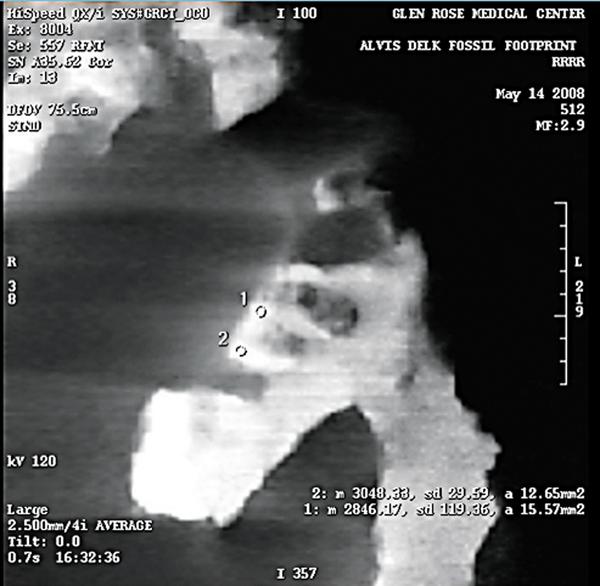
|
|
Fig. 10. CT Scan from Mineral Wells Index 8-12-2008 |
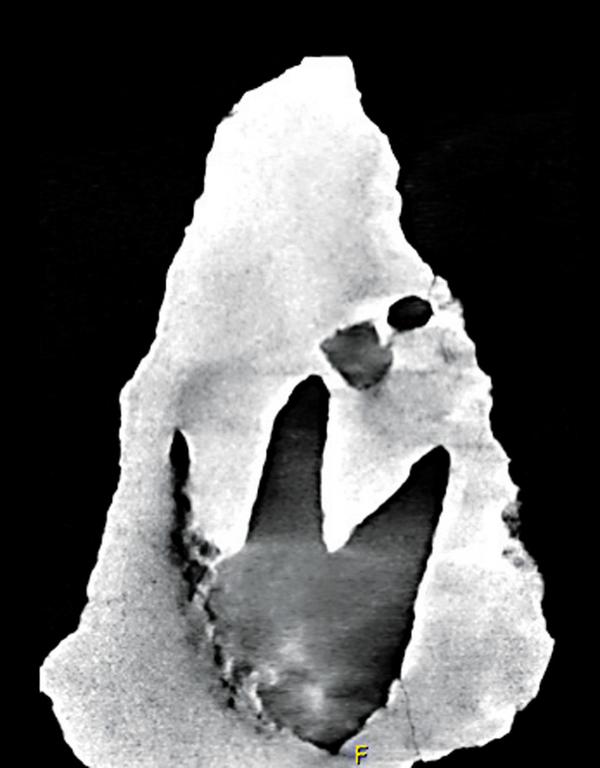
|
|
Fig. 11. Second CT Scan photo from Mineral Wells Index 8-12-2008 |
The August 12, 2008 edition of the Minerals Wells Index ran a follow-up story by David May (2008b), including two new CT scan photos (Figs. 10 and 11), and comments from hospital x-ray technician Charles Meyers suggesting that the scans seemed to confirm that the prints were made while the matrix was soft. The print advocates suggest that the scan in Fig. 10 shows evidence of greater density between the human "toes." However, the same scan also shows a wide, white (supposedly "less dense") area that extends from the top of the slab surface to a considerable depth, and laterally into the "human print" region. This seems to demonstrate that bright areas do not necessarily correspond to specific compaction or impression forces, and this implies to the supposed "high density" areas between the toes. In other words, the light area could well have extended throughout the toe region before toes were carved, giving the false impression that the area between the toes reflects compaction there. The second of the two CT scan photos (Fig. 11) seems to show only the deep "big toe" depression, part of the mid section of the "human" print, and a dinosaur track shape somewhat different than the surface outline. This again raises the question of enhancement or the addition of certain features. (Update: Sometime in 2010 David Lines removed the Delk print scans and photos from his website, without explanation).
The last photo in the set posted by David Lines set shows the Delk slab in relation to several cross sectional scans at: http://www.bible.ca/tracks/patton-delk-track-ct-scan.jpg Although the scan images are rather small in relation to the slab image, making it difficult to confirm certain details, the following observations seem possible. First, the most distinct bands of light color seem to occur most of the rock edges, including areas of its surface, sides, and bottom, even where no depression occurs. This seems to strongly imply that light areas do not necessarily indicate compression or greater density. Indeed, some scans seem to not only lack light bands, but actually show darker regions immediately under the dino print and "big toe" depressions, whereas one would expect light bands if pressure from they were made by foot or digit pressing in sediment. Furthermore, one can see from "Slice 139," which cuts through the middle of the "big toe" depression, that this feature is incredibly deep compared to the other toe marks. The track advocates would have to explain how the big toe could impress that far, and yet leave relatively shallow toe prints on a much higher plane (besides being situated at an odd angle and much farther from the rest of the print than in a normal print).
What seems to have been missing in the CT procedures are proper controls, including comparable scans of known real prints, and known carved prints in similar limestone (including ones with applications of acid and other substances), to better understand the scan results. One important question is what degree and depth density changes are normal or expected in real fossil prints? Another is, were the CT scans calibrate to properly detect them? Medical scans are calibrated for tissue and bone--which are much less dense than rocks. Were they recalibrated in this case? On what standard or basis? What CT numbers correspond to what densities levels and levels of brightness on the scan. There appear to be many important details missing from the reports and videos of the print supporters.
Juby notes that if acid were applied to carved features, it would tend to reduce rather than increase the density of the rock at those places. However, evidently he and Baugh did not consider (or test for) the possibility that other solutions such as preservatives or consolidants might have been applied to the rock surface or portions of it that would have had the opposite effect. They also evidently failed to consider the possibility that some of the features they interpret as "compression" areas might be due to artifacts (incidental effects) of the scanning process itself. As it turns out, this is a significant likelihood. Gary Hurd cites Ketcham and Carlson (2001) on the application of scanning technology in geological sciences, and an associated summary at a University of Texas at Austin, Department of Geological Sciences website , describing an effect known as "beam hardening." As UA authors explain, "The most commonly encountered artifact in CT scanning is beam hardening, which causes the edges of an object to appear brighter than the center, even if the material is the same throughout." This effect and other potentially misleading scanning effects described in these sources, along with the inconsistencies described above, suggests that what Baugh and supporters see as compression features may have nothing to do with compression.
As another case in point, an anonymous article at Don Patton's website features a photograph of the Delk slab and CT scan through the supposed big toe and dino print. An arrow pointing to the region under the toe reads "Following Contours Falsify Carving." However, one can see that a light band extends around most of the slab, even the top and bottom surfaces where no print depression occurs, again refuting the notion that the light areas must indicate greater density or compression. Also, although the caption only indicates "human toe" above the arrow, it is clearly the "big toe" that this scan cut through, which is the least likely depression to be a real toe mark, and most likely to be a natural depression due to some other cause. Patton does not address the issue of beam hardening and its ability to create a false appearance of high density regions. In short, when all factors and data presented so far are considered, the CT results seem to do more to undermine the authenticity of the find than support it.
Juby also remarks, "To claim that portions of the tracks show no higher density and thus must have been carved is a ludicrous argument: Did the carver only carve portions of the tracks?" The answer is, yes; quite possibly, especially considering that an early carver in Glen Rose is known to have done just that. Carving from some starting depressions saves time, and giving the carver the benefit of the doubt, its possible that he saw a hole and indistinct depression that he thought was a human track, and "enhanced" it to make it clear and unmistakable.
Juby further implies on his website that skepticism about alleged human tracks in ancient rock is due entirely to evolutionary bias (Juby, 2008). However, this is dispelled by the fact even major creationist groups such as the Institute for Creation Research (ICR) and Answers in Genesis (AIG) have questioned or rejected previous Paluxy "man track" claims, and to my knowledge, none to date have endorsed the Delk specimen. Likewise, several internet blogs have been discussing the Delk find, and the large majority of contributors (including many laymen and creationists as well as mainstream scientists) are expressing strong skepticism about it. Many are calling it an obvious fake (or other terms to that effect), often pointing out the above-mentioned problems, and more. Not mincing words about the appearance of the "big toe," one blogger remarked that it "looks like it was formed with a tent pole." Even Delk's own daughter Kristi Delk, a geology major at Tarleton State University, expressed doubts about the find, stating, "I haven't come to terms with it...I am skeptical, actually."(May, 2008)
Although both scientific and public opinion seems to be running heavily against the authenticity of the find, some of its supporters have remarked that it has not been "disproven." This reveals a basic misunderstandings about the scientific process. When extraordinary claims are made, the burden is on the claimants to properly support their assertions in a thoroughly detailed scientific report, not on skeptics to disprove them. Baugh has not come close to properly supporting his claims about the Delk print, nor any of the "over 80" human prints he claims to have documented in Cretaceous rock (Baugh, 2008). Even major creationist groups such as "Answers in Genesis" agree, and acknowledge that there has never been a compelling case of human remains or footprints in Mesozoic rock (Snelling, 1991). Second, science does not ultimately deal in absolute proof or disproof, but in varying degrees evidence for or against a concept or hypothesis. As the saying goes, "extraordinary claims require extraordinary evidence." In this case, the Delk Print advocates have fallen far short.
David Lines suggests there is a "wall of silence" about the find from the academic community, and that they "can't argue against it, so they just hope it will go away" (Kennedy, 2008). However, his criticism rings hollow for a number of reasons. First, the find had only been made public days earlier, and was done so with only sketchy information. Second, most scientists can readily see the serious morphological problems with the Delk print, and are familiar with the massive evidence for an old earth, so they are probably not inclined to spend valuable time critiquing an obvious fake. This is not evidence of bias, but prudence and common sense. Third, besides me, a number of mainstream workers have addressed the print, including Hurd (2008), Darrell (2008), and Phillip Murray, a paleontologist at Tarelton State University in Stephenville (May, 2008). Ian Juby (who promotes the Delk track on a Youtube video as well as his website) cites anti-creationist prejudice from mainstream journals as the reason why creationists have not published a detailed scientific paper on the find. However, this does not explain why a report of comparable academic rigor hasn't been published even in the creationist press, although he promises that one is forthcoming.
Baugh was quoted by May (2008a) as stating that he is "so confident in the authenticity of the specimen that he is ready to put his reputation entirely on the line." Not to worry. Considering that he has a reputation for promoting sensational and unsupported claims, I am confident that his reputation will remain intact with this latest find.
The Alvis Delk Print is not a convincing human footprint in ancient rock. Its advocates have failed to present the necessary data and details to adequately support their assertions. Even putting aside the extensive independent evidence that humans did not exist until long after the Cretaceous Period, the collective weight of several lines of evidence, including the uncertain circumstances of the discovery, lack of in situ documentation, the knowledge that similar tracks have been carved in the Glen Rose area, the serious morphological abnormalities in the prints, and the considerations about potentially misleading scanning artifacts such as beam hardening, point to the strong likelihood that both the "human footprint" and dinosaur track on this loose slab were carved or heavily altered from less distinct depressions.
NOTE: An earlier version of this draft (which was not yet linked to my Paluxy website) incorrectly identified Zana Douglas as Alvis Delk's granddaughter, and indicated that she described her grandfather as carving tracks, based on my own misreading of a newspaper article. In fact Zana Douglas is a member of the Adams family, and evidently it was her grandfather George Adams she was referring to, not Alvis Delk. I apologize for any problems this may have caused for Ms. Douglas or anyone in the Delk or Adams family. Thanks.
Baugh, Carl E, 2008, " Creation Museum website article: "Alvis Delk Cretaceous Footprint" article at: http://www.creationevidence.org/index.php?option=com_content&task=view&id=48&Itemid=24
Darrell, Ed, 2008 (Aug. 5). "Fred Flintstone waded here: Hoaxsters ready to teach creationism to Texas kids" Millard Fillmore's Bathtub blog at: http://timpanogos.wordpress.com/2008/08/05/fred-flintstone-waded-here-hoaxsters-ready-to-teach-creationism-to-texas-kids/
Godfrey, Laurie, 1985, "Footnotes of an Anatomist," Creation/Evolution, Issue 15, Volume 5, Number 1 (Winter 1985)
Hurd, Gary. Stones and Bones website blog.
Juby, Ian. "Examining the Delk Track," August, 2008 website article.
Kennedy, Bud, 2008 (Aug 10), Fort Worth Star-Telegram. "Human Footprints Along with Dinosaur Tracks?"
Ketcham, R.A. and Carlson, W.D. 2001. "Acquisition, optimization and interpretation of X-ray computed tomographic imagery: Applications to the geosciences." Computers and Geosciences, 27, 381-400.
Kuban, Glen J. 2006. "On the Heels of Dinosaurs." Website article at: http://paleo.cc/paluxy/onheels.htm
Kuban, Glen J. and Gregg Wilkerson, 1989, The Burdick Print at http://paleo.cc/paluxy/wilker5.htm
Lines, David. 2008 web links at http://linesden.com/cem/delk/delk_ct_scan_long.pdf (lines, 2008).
May, David. 2008a (July 28, 2008). "Rock-solid Proof?" Mineral Wells Index. On line version at: http://www.mineralwellsindex.com/homepage/local_story_210093256.html
May, David. 2008b (August 12, 2008). "One Step at a Time." Mineral Wells Index. On line version at: http://www.mineralwellsindex.com/local/local_story_224120721.html
Snelling, Andrew A., 1991. Website article at: www.answersingenesis.org/creation/v14/i1/humanfossils.asp. Originally published in: Creation 14 (1):28-33, December 1991.